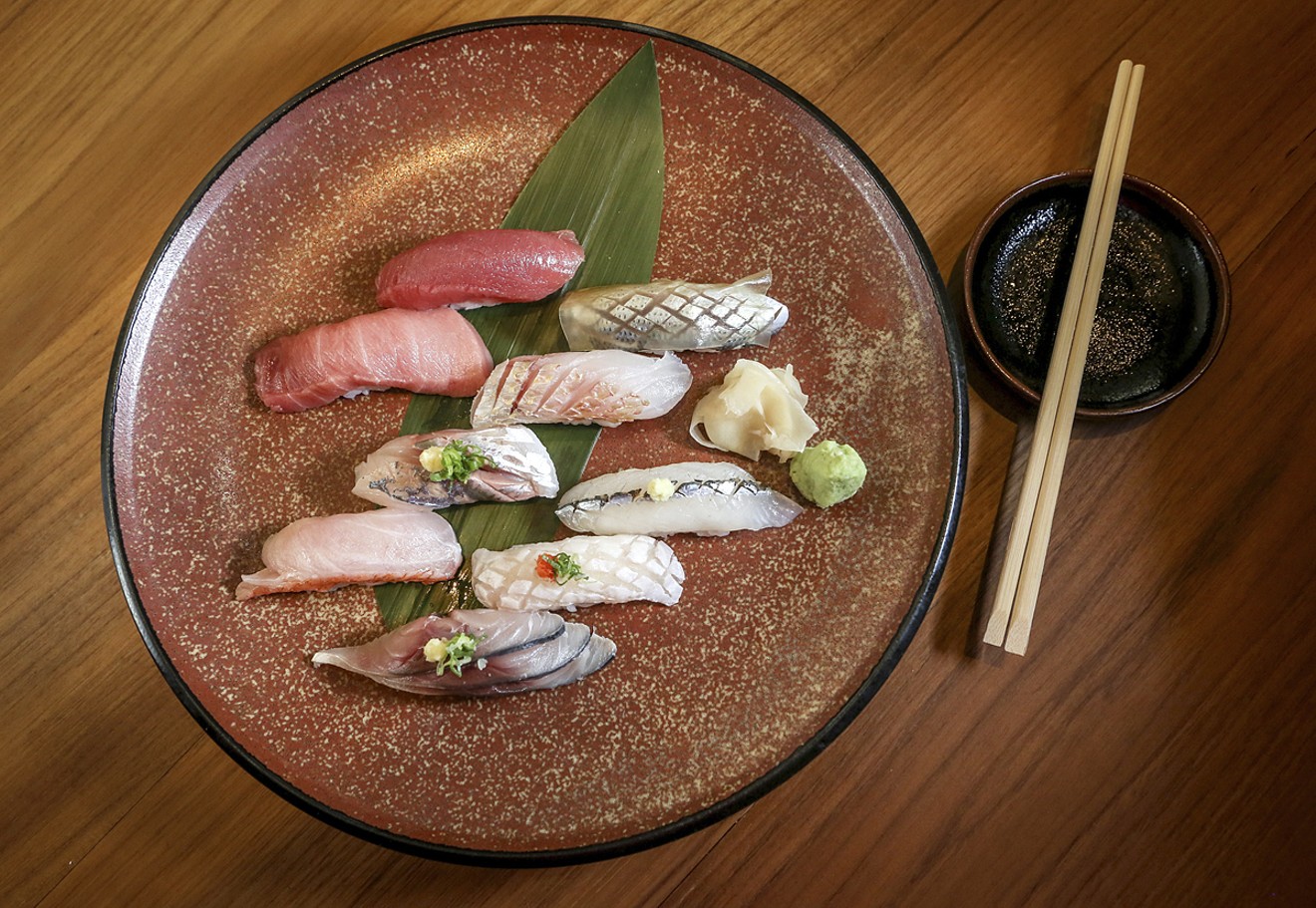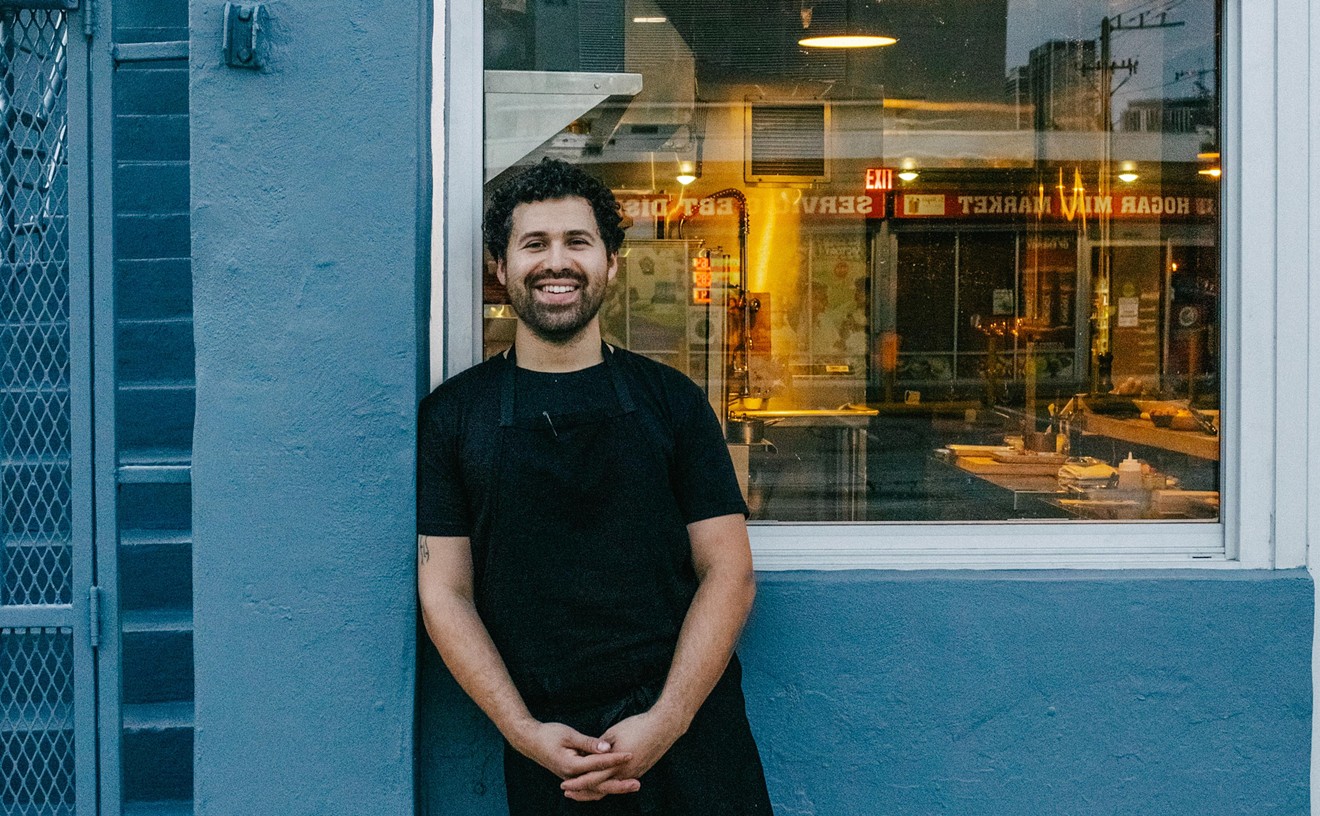The menu at Blue Ribbon Sushi Bar & Grill is packed with traditional vegetable rolls that can be difficult to find amid Miami Beach's cacophony of sushi spots. One is loaded with threads of loamy enoki mushrooms. Another wraps rice and seaweed paper around crunchy matchsticks of burdock root that taste like a hybrid of jícama and sweet potato. The best contain the slightly slimy yet nutty and über-savory fermented soybeans called natto.
Such classic Japanese offerings are all too rare in Miami. Most new places abandon the spirit of the cuisine. However, Blue Ribbon, the famed New York City brand's first Miami outpost, opened two months ago with an impressive, expanding, and reasonably priced arsenal of hard-to-find fish.
The first Blue Ribbon was in many ways an accident. After attending Le Cordon Bleu in Paris, Eric Bromberg opened a white-tablecloth French restaurant in Lower Manhattan called the Crystal Room in 1992. The place lasted ten weeks. Then Bromberg made the staid space more casual and overhauled the menu to include burgers and pu-pu platters alongside racks of lamb and fruits de mer. Soon his brother Bruce came aboard, and Blue Ribbon was born. In 1995, the Brombergs' raw bar was an obvious hit, so they set out to open a small fish market.
The meat is buttery, redolent with oceanic notes of kelp and sea salt.
tweet this
Then, after becoming obsessed with a Midtown Manhattan sushi spot, they partnered with its owner, Toshi Ueki. Today the trio oversees seven restaurants that serve varying types of Japanese cuisine in New York City, Los Angeles, and Las Vegas.
Three years ago, they decided to open a sushi restaurant in Miami Beach. What resulted is a rare, happy oasis. The Plymouth Hotel sits two blocks from Collins Avenue, far enough that the blaring traffic and drunken tourists are mostly out of earshot. Inside, chunky furniture in rich earth tones shaded by leaning palm fronds evokes the art deco era. That aesthetic is reinforced by bold murals that combine art deco with gothic imagery. Cross into the understated restaurant and you'll likely hear the staff bellow out "Irasshaimase!" for a Japanese welcome. The room is covered in narrow onyx brick, bookended on one side by a low-backed banquette with a red floral pattern. The main source of light emanates from the sushi bar, where a half-dozen chefs toil.

Each day, a printed menu insert lists the special and seasonal varieties of fish on hand. All of it comes from True World Seafood, a national fish distributor specializing in sushi, which the Brombergs say employs buyers in Japan who scour the country's market to stock Blue Ribbon's coolers.
There are only a few other places in the city — including Makoto, Naoe, and Myumi — that offer many of the species you'll find at Blue Ribbon. There's a proclivity for silver-skinned fish, which in America are often overlooked because of their sometimes fishy flavor profiles. More important is this place's vast, evolving nigiri and sashimi offerings, which could be a gateway for legions of diners to move beyond tuna, salmon, and shrimp.
Start with a firm piece of engawa, which is culled from the muscular flank of a flounder. It provides the texture of a pristine piece of lean tuna but with a more neutral, sweeter flavor.
Next, try a glittery slice of the gizzard shad called kohada. It is quickly cured in salt and then briefly washed in rice vinegar to tighten the flesh and draw out some of its oiliness. Just before serving, the skin is crosshatched, yielding a gorgeous diamond pattern that also helps soften each bite.

Even more delicate is the halfbeak, or sayori, which arrives with just a narrow streak of silver skin atop white translucent flesh that isn't too firm or oily. It's an ideal starting point for those looking to move into more powerfully flavored species.
The Japanese porgy, called kasugodai, is a bit more assertive. The small triangle of skin left on the pale-pink flesh hits you with a smoky flavor, while the meat is buttery, redolent with oceanic notes of kelp and sea salt.
The Japanese red snapper, madai, is sweet. It is slightly fibrous, which helps to firm up its watery texture and gives it a smooth, velvety feel. It's not that different from what's found in the supple slabs of fatty bluefin tuna belly offered for $14 apiece. At $6 a hit, the madai is far more reasonable, and you'll also be doing your part to save bluefins from extinction.
The horse mackerel was the lone miss. A leathery, almost dried-out texture seemed to indicate the fish was cut long before it was served. This was confirmed by the rainbow of oxidation on what should have been pearly-pink flesh.
A handful of rolls filled with various bounties of the sea also help to erase bad memories of too much cream cheese at subpar places. In one that comes with blue crab and shiso, the sweet knuckle meat is brightened by the minty, razor-edge herb, which adds a gentle acidity that snaps your tongue to attention. A spicy scallop and smelt roe will also grab your attention. The bivalve itself is intensely sweet, with just a hit of oceanic salt amplified by the briny fish eggs.
There's also a lengthy list of hot offerings that includes matzo-crusted fried chicken, which earned a cult following in New York. The desiccated crackers, in combination with egg whites and a Japanese chili spice, create a crust that is more about texture than flavor. It fuses with the skin and creates a superlight, crunchy exterior that complements the juicy flesh inside. An accompanying dish of wasabi-spiked honey is a smart analog for the hot sauce and honey that are often drizzled over Southern-style fried chicken.

Another notable plate bears three gently browned hunks of cobia deftly seasoned and seared. A moment less on the grill would've left the sturdy, juicy flesh chewy, and a moment longer would have dried it out. The taste and texture are similar to swordfish. A bright, acidic sauce with tomatillo and sharp ponzu, combined with sweet corn and charred cherry tomatoes, sharpens each bite.
The kitchen also steams what might be the city's best chawanmushi. Too often, the savory egg custard is congealed with gelatin, giving it the near-perfect texture and appearance of a panna cotta. Blue Ribbon's version, blended with dashi and studded with salty-sweet bits of crab, egg, and eel, is rougher-looking but far more refined. Mouthfuls of the tender custard are sometimes yolky and at other times filled with briny ocean goodness.
But it's the sushi bar that's most alluring and provides the greatest incentive to return. Blue Ribbon's offerings in Miami Beach aren't quite as ambitious or exotic as those in New York, where giant clams and house-cured octopus grace the menu. Yet the place is a reason to hope for better sushi. This is vitally important considering the recent closing of Japanese Market, the beloved North Bay Village sushi counter, and the impending hiatus of Myumi, the Wynwood Yard's omakase food truck, which is preparing to move into a place in a Little Haiti food hall that's under construction.
Blue Ribbon has a bright future. With any luck, the sayori, the kohada, and the kasugodai are just the beginning.
"We're going to try everything we can get in pristine form," Eric Bromberg says. "Our real focus is probing what guests want and building the most exciting menu we can."
Blue Ribbon Sushi Bar & Grill
336 21st St., Miami Beach; 305-800-0404; blueribbonrestaurants.com. Monday through Thursday 6 to 11 p.m., Friday and Saturday 6 p.m. to midnight, Sunday 6 to 10 p.m.
- Grilled avocado $8
- Chawanmushi $11
- Assorted nigiri $6 to $14
- Blue Ribbon fried chicken $26
- Cobia $35











